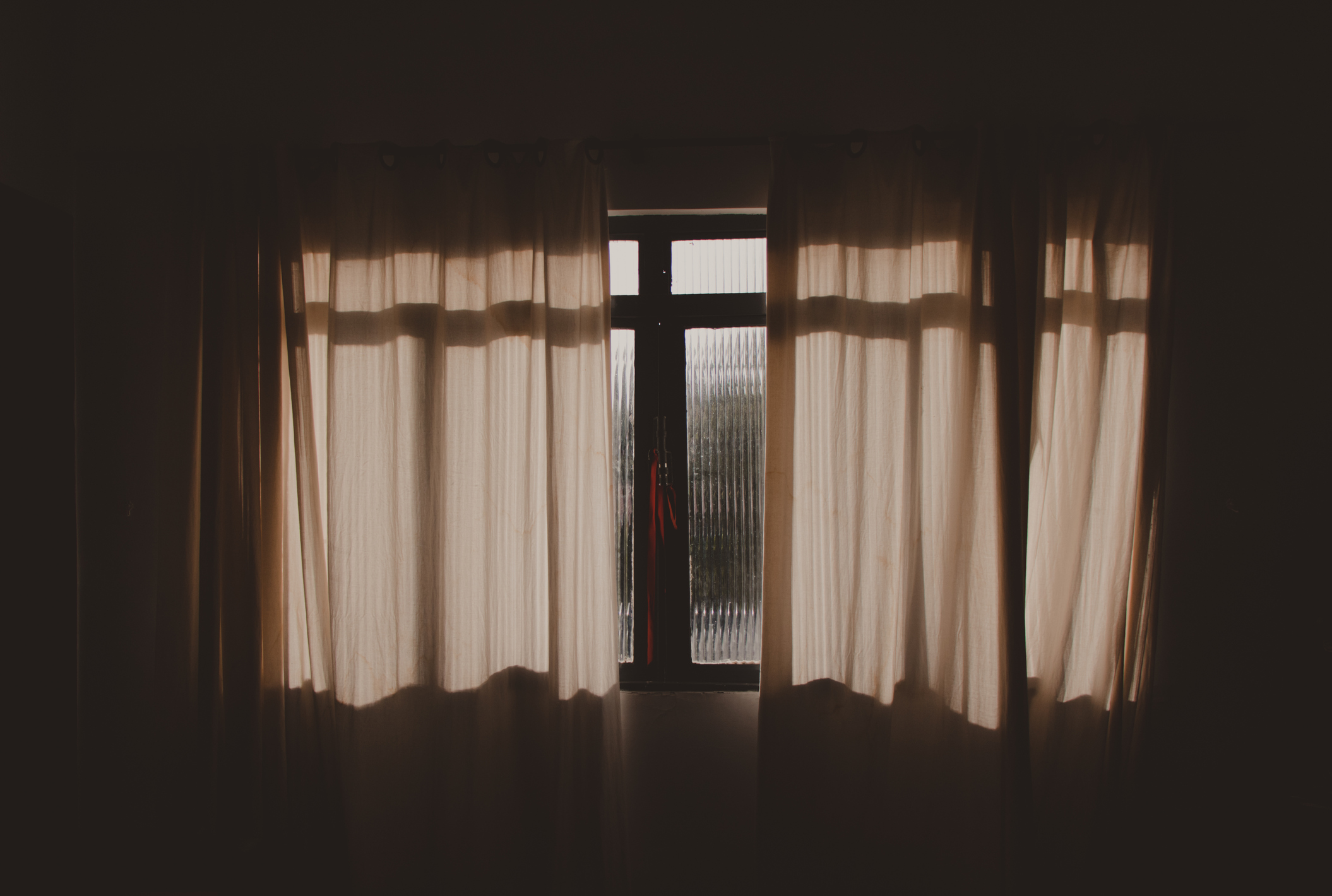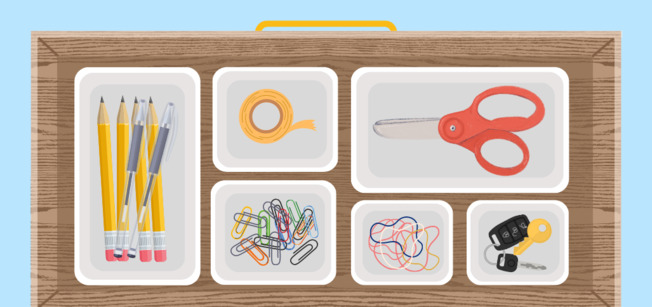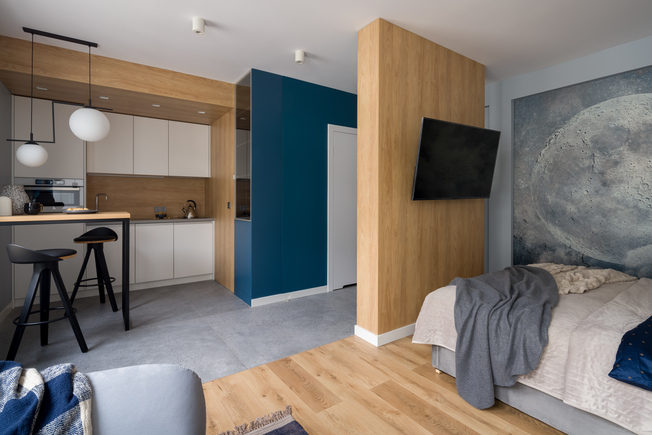
Tips for When Your Apartment Doesn’t Get Natural Light

By Lilly Milman
Aug 14, 2024
A big south-facing window can be a game-changer in an apartment, allowing you to make tons of compromises in the name of natural sunlight. Meanwhile, a dark apartment that lacks large windows — or windows facing the right direction — can feel imperfect even if it comes with the most luxurious amenities. However, we’re here to tell you that you don’t need to give up on your apartment, even if it falls more into the latter category.
Natural light is hard to replicate, but there are a few tips and tricks you can try out to make the most of the light you do get and to make your home look sunnier.
How to Make Your Apartment Feel Lighter with Home Decor Pieces
If your landlord prefers you don’t make any changes at all to your apartment, then you don’t have many options outside of your decor and organization choices when it comes to lightening up your space — and the former will cost you. If you do have the budget to buy a few pieces and up your interior design game though, check out the below tips to help combat a lack of natural light.
Use Mirrors to Reflect and Multiply What Light You Are Getting
Mirrors are a historic hack for making a room feel bigger and brighter. For hundreds of years, people have been hanging them on their walls or building them into furniture for exactly that purpose. Here’s how you can place mirrors to improve their functionality in a low-light room:
- First, find a mirror you like (antiques found at secondhand stores, estate sales, or Facebook Marketplace may be cheaper, but just make sure that the glass is clean and not distorted).
- Next, figure out which wall the light hits for the majority of the day by following the sunbeams you see throughout the morning and afternoon.
- Hang your mirror (or place it, if it’s a floor mirror) in that spot and watch your room feel twice as bright.
Some people even elect to have multiple mirrors in their living space to compound the effect, which makes a huge difference in a dark space.
Use Lamps, Sconces, and Overhead Lighting to Complement Natural Light
What’s worse than an apartment without a lot of natural light is an apartment with no natural light and no built-in artificial lighting. Luckily, there’s a lot of renter-friendly lighting options you can invest in to make your apartment feel like it’s getting a lot more sun than it is.
Here’s a few tips:
- Try switching to full-spectrum lightbulbs, which mimic natural light.
- If there’s no overhead lighting, consider plug-in wall sconces or chandeliers that require no electrical work. String lights are another option, but sconces and similar light fixtures may give a more elevated look.
- Invest in a mix of floor and table lamps. Layering multiple light sources can help brighten up an entire room, rather than bringing the focus to just one corner of it with a single floor lamp, so having multiple lamps will help you more closely create the look of natural light. Go the extra mile by testing out a few different lampshades to find ones that let in the most light as well.
- Consider investing in a wake-up alarm light or a light therapy lamp for your bedroom, which can help with seasonal affective disorder (SAD, also known as seasonal depression).
Use Light Colors to Make the Space Feel More Open
Dark and moody colors can make an apartment give off fun Victorian chic vibes, but in a small and dark apartment, they can also make the setting feel drearier. Even if it isn’t quite your style, you may want to try out some lighter design elements. Here’s a few options:
- Adding a light-colored area rug, perhaps in a light beige or white, can give the illusion of more light in a dark room. If you prefer color, try a baby blue or pink.
- The same goes for your linens. Look for white or similar sheets for your bed, and soft, bright colors for any upholstered furnishings.
- As far as your curtains go, you want to be careful about not blocking out what light are you are getting from your windows. Don’t use thick fabrics like velvet, especially not in dark colors. Instead, opt for more sheer curtains, in natural fabrics like linens or cottons. If you don’t get much natural light in through your window anyway, heavy curtains are less of a necessity.
How to Make Your Apartment Feel Lighter by Tidying Up
If you aren’t looking to break the bank but want to put some effort into brightening up a dark room, there’s a lot of progress you can make just by rearranging your furniture and keeping things tidy. Below, we offer a few (free!) things you can do to let in more natural light.
Move Bulky Furniture Away From Windows
Similar to what we said about window treatments, you want to avoid letting large furniture pieces prevent the little natural light you are getting from reaching the rest of the room. So, if you have any large bookshelves, dressers, or armoires directly to the left or right of a small window in a dark room, you may want to move those around. Put them in darker corners, so they won’t cast large shadows in the way of your light. Large plants may be having the same effect, so think twice about placing a tall plant right in front of or next to one of your only windows.
Clean Your Windows Monthly
It may not seem like it will make a big difference, but a monthly clean of your windows will ensure that there are no smudges, dirt, or film blocking light from coming in. If your windows don’t open all the way or allow for easy cleaning of the exterior, try asking your landlord for help.
Keep Clutter to a Minimum
It can be difficult to separate from your stuff, but in general, a cluttered room is a cramped feeling room. Try to stay on top of regularly doing laundry, putting clothes and objects away when you’re not using them, and keeping your room clean. If you have too much clutter out, it could give the effect of absorbing your small amount of natural light.
How to Make Your Apartment Feel Lighter with DIY Projects
If your landlord is okay with you making more hands-on renter-friendly adjustments to your apartment, then there’s a few bigger DIY projects you may want to take on to maximize the light in your space. As always with renter-friendly hacks, just make sure you’re able to return the apartment back to its initial state before changing anything.
Paint Your Walls a Lighter Color
Painting your walls a lighter color will help reflect light rather than absorb it, so look into white or off-white paint colors. Peel-and-stick wallpaper is another option if you want to introduce texture or a pattern to your walls; as a rule of thumb, just try to keep it simple since you’ll be committing to what you pick for a while. An added bonus is that light wall colors ofter make a small space appear bigger, too.
Brighten Up Your Floors Semi-Permanently With Adhesive Tiles
You can use adhesive floor tiling to brighten up the floor too — so if you have dark walls and dark wood or linoleum flooring, you’ll want to lighten up at least one or the other (but if you have time, both!).
Add Reflective Finishes to Your Furniture
Breathe new life into your furnishings by adding glossy, metallic, or otherwise reflective surfaces and finishes where possible to reflect even more light back into your room.
Remove Doors to Stop Blocking Light
If you live in a one-bedroom apartment that you don’t mind turning into a studio-like apartment, then you can even remove your bedroom door. While this may sound a little crazy, doors create shadows when they’re open and block the passage of light when they’re closed. If increasing natural light in your apartment is your goal, then this (slightly drastic) step can help you achieve it.
Top cities
Atlanta Apartments
1,825 apartments starting at $630/month
Austin Apartments
6,133 apartments starting at $600/month
Baltimore Apartments
1,423 apartments starting at $640/month
Boston Apartments
5,609 apartments starting at $425/month
Charlotte Apartments
2,980 apartments starting at $570/month
Chicago Apartments
5,458 apartments starting at $400/month
Dallas Apartments
5,455 apartments starting at $625/month
Fort Worth Apartments
2,695 apartments starting at $695/month
Houston Apartments
5,813 apartments starting at $450/month
Las Vegas Apartments
1,016 apartments starting at $795/month
Los Angeles Apartments
12,712 apartments starting at $750/month
Miami Apartments
702 apartments starting at $1,200/month
Milwaukee Apartments
1,106 apartments starting at $475/month
New York Apartments
8,874 apartments starting at $600/month
Oakland Apartments
983 apartments starting at $850/month
Orlando Apartments
877 apartments starting at $895/month
Philadelphia Apartments
3,614 apartments starting at $500/month
Phoenix Apartments
3,461 apartments starting at $592/month
Pittsburgh Apartments
1,382 apartments starting at $590/month
Portland Apartments
2,260 apartments starting at $575/month
Raleigh Apartments
1,471 apartments starting at $550/month
San Antonio Apartments
3,372 apartments starting at $525/month
San Diego Apartments
2,860 apartments starting at $650/month
San Francisco Apartments
664 apartments starting at $500/month
San Jose Apartments
516 apartments starting at $1,000/month
Seattle Apartments
3,520 apartments starting at $452/month
Tampa Apartments
776 apartments starting at $808/month
Washington DC Apartments
2,256 apartments starting at $910/month


